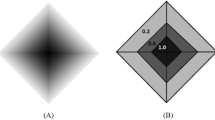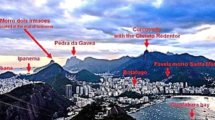Abstract
Direction is an important spatial concept that is used in many fields such as geographic information systems(GIS) and image interpretation. It is also frequently used as a selection condition in spatial queries. Previous work has modeled direction as a relational predicate between spatial objects. Conversely, in this paper, we model direction as a new kind of spatial object using the concepts of vectors, points and angles. The basic approach is to model direction as a unit vector. This novel view of direction has several obvious advantages: Being modeled as a spatial object, a direction object can have its own attributes and operation set. Secondly, new spatial data types such as oriented spatial objects and open spatial objects can be defined at the abstract object level. Finally, the object view of direction makes direction reasoning easy and also reduces the need for a large number of inference rules. These features are important in spatial query processing and optimization. The applicability of the direction model is demonstrated by geographic query examples.
Similar content being viewed by others
References
A. Frank. “Qualitative Spatial Reasoning: Cardinal Directions as an Example,” International Journal of Geographical Information Systems, Vol. 10(3):269-290, 1996.
J. Allen. “Maintaining Knowledge about Temporal Intervals,” Communications of the ACM, Vol. 26(11):832-843, 1983.
D. Papadias, M. Egenhofer, and J. Sharma. “Hierarchical Reasoning about Direction Relations,” In Fourth ACM Workshop on Advances in Geographic Information Systems, pages 105-112. ACM, 1996.
A. Frank. “Qualitative Spatial Reasoning about Cardinal Directions,” in Auto carto 10, D. Mark and D. White, eds., Baltimore, MD, pages 148-167, 1991.
C. Freksa. “Temporal Reasoning Based on Semi-Intervals,” Artificial Intelligence, Vol. 54:199-227, 1992.
C. Freksa. “Using Orientation Information for Qualitative Spatial Reasoning,” Theories and Methods of Spatio-Temporal Reasoning Geographic Space, Vol. 639:162-178, 1992.
Klaus-Peter Gapp. “Basic Meanings of Spatial relations: Computation and Evaluation in 3-D space,” AAAI, Vol. 2:1393-1398, 1994.
R. Goyal and M. Egenhofer. “The Direction-Relation Matrix: A Representation of Direction Relations for Extended Spatial Objects,” in UCGIS Annual Assembly and Summer Retreat, Bar Harbor, ME, 1997.
G. Retz-Schmidt. “Various Views on Spatial Prepositions,” AI Magazine, Vol. 9(2):95-105, 1988.
J. Gurney and E. Kilpple. Composing Conceptual Structure for Spoken Natural Language in a Virtual Reality Environment 1997.
R.H. Guting. “An Introduction to Spatial Database Systems,” VLDB, Vol. 3:357-399, 1994.
Open GIS Consortium Inc. Opengis simple features specification for sql. http://www.opengis.org.
Open GIS Consortium Inc. Spatial reference systems. http://www.opengis.org/techno/specs.htm.
E. Jungert. “The observer's point of view: An Extension of Symbolic Projections,” Theories and Methods of Spatial-Temporal Reasoning in Geographic Space, Vol. 639:179-195, 1992.
D. Papadias and T. Sellis. “Qualitative representation of Spatial Knowledge in Two-Dimensional Space,” VLDB Journal, Vol. 3(4):479-516, 1994.
D.J. Peuquet and Z. Ci-Xiang. “An Algorithm to Determine the Directional Relationship Between Arbitrarily-shaped Polygons in the plane,” Pattern Recognition, Vol. 20(1):65-74, 1987.
M.H. Protter and C.B. Morrey. Modern Mathematical Analysis. Addison-Wesley Publishing Company, Inc., Reading, MA 1996.
P.W. Huang and Y.R. Jean. “Using 2-D C+-String As Spatial Knowledge Representation For Image Database Systems,” Pattern Recognition, Vol. 30(10):1249-1257, 1994.
D.F. Rogers. Mathematical Elements for Computer Graphics. McGraw-Hill Publishing Company, 1990.
S. Shekhar, S. Ravada, A. Fettesrer, X. Liu, and C.T. Lu. Spatial Databases: Accomplishments and Research Needs, University of Minnesota technical report, Csci TR97-016, 1997.
S. Shekhar S. Ravada, V. Kumar, and etc. “Parallelizing a GIS on a Shared-Address Space Architecture,” IEEE Computer, Vol. 29(12):42-48, 1996.
S. Shekhar, M. Coyle, and etc. “Data Models in Geographic Information Systems,” CACM, Vol. 40(4):103-111, 1997.
S. Shekhar and D.R. Liu. “CCAM: A Connectivity-Clustered Access Method for Networks and Network Computations,” TKDE, Vol. 9(1):102-119, 1997.
S. shekhar, X. Liu and S. Chawla. “Equivalence Classes of Direction Objects and Applications,” Tech. Report TR99-027, University of Minnesota, Minneapolis, MN 55455.
J.D. Ullman and J. Widom. A First Course in Database Systems, Prentice Hall, Upper Saddle River, NJ 1997.
Y.I. Chang and B.Y. Yang. “A Prime-Number-Based Matrix Strategy for Efficient Iconic Indexing of Symbolic Pictures,” Pattern Recognition, Vol. 30(10):1-13, 1997.
Author information
Authors and Affiliations
Rights and permissions
About this article
Cite this article
Shekhar, S., Liu, X. & Chawla, S. An Object Model of Direction and Its Implications. GeoInformatica 3, 357–379 (1999). https://doi.org/10.1023/A:1009888814892
Issue Date:
DOI: https://doi.org/10.1023/A:1009888814892




